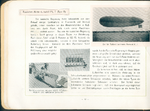
Russian airships
Encyclopedia

Rigid airship
A rigid airship is a type of airship in which the envelope retained its shape by the use of an internal structural framework rather than by being forced into shape by the pressure of the lifting gas within the envelope as used in blimps and semi-rigid airships.Rigid airships were produced and...
and semi-rigid airship
Semi-rigid airship
Semi-rigid airships are airships with a partial framework. These often consist of a rigid, or occasionally, flexible, keel frame along the long axis under the aerodynamic hull envelope. The partial framework can also be located inside the hull...
s used in or built in Russia and the Soviet Union.

French invasion of Russia
The French invasion of Russia of 1812 was a turning point in the Napoleonic Wars. It reduced the French and allied invasion forces to a tiny fraction of their initial strength and triggered a major shift in European politics as it dramatically weakened French hegemony in Europe...
, Alexander I
Alexander I of Russia
Alexander I of Russia , served as Emperor of Russia from 23 March 1801 to 1 December 1825 and the first Russian King of Poland from 1815 to 1825. He was also the first Russian Grand Duke of Finland and Lithuania....
commissioned the German engineer Leppig to build a large fish-shaped airship propelled by fins: the craft inflated but became damaged and failed to lift off.
Like other nations in the early 1900s, Russia began researching and developing its own airships. Russia also purchased airships from the French and then from the German firm Luft-Fahrzeug-Gesellschaft
Luft-Fahrzeug-Gesellschaft
Luft-Fahrzeug-Gesellschaft, also referred to as LFG, was a German aircraft manufacturer during World War I. They are best known for their various "Roland" designs, notably the Roland C.II and Roland D.VI, although they also produced a number of airships and experimental...
, and in the 1920s and 1930s built others such as the USSR-V5 and the SSSR-V6 OSOAVIAKhIM with help from the Italian Umberto Nobile
Umberto Nobile
Umberto Nobile was an Italian aeronautical engineer and Arctic explorer. Nobile was a developer and promoter of semi-rigid airships during the Golden Age of Aviation between the two World Wars...
. Much of Soviet airship development remains obscure; the proclaimed rigid "Zeppelin"-style airships announced in the five year plans were probably pure propaganda while some may have been built.
In the early 1910s the German firm Luft-Fahrzeug-Gesellschaft
Luft-Fahrzeug-Gesellschaft
Luft-Fahrzeug-Gesellschaft, also referred to as LFG, was a German aircraft manufacturer during World War I. They are best known for their various "Roland" designs, notably the Roland C.II and Roland D.VI, although they also produced a number of airships and experimental...
delivered the small semi-rigid PL 7 "Grif", and the PL 14 Burewestnik to the Russian military.
The Albatross was used in World War I
World War I
World War I , which was predominantly called the World War or the Great War from its occurrence until 1939, and the First World War or World War I thereafter, was a major war centred in Europe that began on 28 July 1914 and lasted until 11 November 1918...
.
From 1920 to 1947 the Soviet Union apparently built a series of airships mostly designated with the prefix "СССР-B".
In 1944 the airship Pobeda (Russian Победа) was built and later used to transport cargo, mainly hydrogen gas for balloons used to train parachute jumpers, on short routes from 20 to 500 kilometres long. It crashed on 29 January 1947, killing the whole crew. UdSSR-W12 was another airship used for the same purpose, delivering hydrogen gas and cargo.
After World War II airships were still used for connecting airfields and research. In 1946 the last passenger airship, the "Patriot", entered service but by 1950 regular inland service had ended.
See also
- Imperial Russian Air ForceImperial Russian Air ForceThe Imperial Russian Air Force existed in the Russian Empire between 1910 and 1917....
- Aviation historyAviation historyThe history of aviation has extended over more than two thousand years from the earliest attempts in kites and gliders to powered heavier-than-air, supersonic and hypersonic flight.The first form of man-made flying objects were kites...

